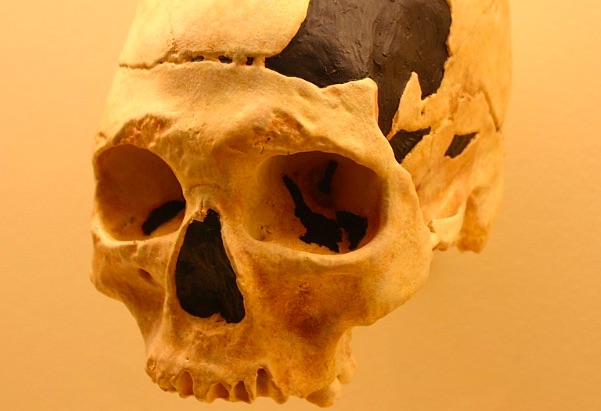Peștera cu Oase (Romanian pronunciation: [ˈpeʃtera ku ˈo̯ase], meaning “The Cave with Bones”) is a system of 12 karstic galleries and chambers located near the city Anina, in the Caraș-Severin county, southwestern Romania, where some of the oldest European early modern human (EEMH) remains, between 37,000 and 42,000 years old, have been found.[1][2]
https://en.wikipedia.org/wiki/Peștera_cu_Oase
オアセ人(Oase)の骨はルーマニアで発見された。オアセ人(Oase)はY染色体ハプログループK1aを持っていたらしい。Y染色体ハプログループK1aの発祥はおそらく東アジアであったかもしれない。
Y染色体ハプログループNOはY染色体ハプログループK1aの子孫である。オアセ人は東アジアから欧州へと移動したかもしれない。
オアセ人
Oase1
In 2015 genetics research revealed that the Oase 1 fossil had a recent Neanderthal ancestor, with an estimated 5-11% Neanderthal autosomal DNA. The specimen’s 12th chromosome was 50% Neanderthal.[5][6]
https://en.wikipedia.org/wiki/Peștera_cu_Oase
もしオアセ人1が5〜11パーセントのネアンデルタール人由来の Neanderthal autosomal DNA (これは核ゲノムのことであるのだろうか?)を持っていたならば、彼の祖父bの母がネアンデルタール人であったかもしれない。この場合、彼の祖父の父aがK2aを持つホモ・サピエンスであり、その妻がネアンデルタール人であったかもしれない。
この時、彼の祖父bは父ホモ・サピエンスであって、母ネアンデルタールになった。ミトコンドリアDNAはネアンデルタール由来であるのだろうか?ただし、彼の祖父bがホモ・サピエンスの雌と交雑すると、祖父のbの息子c(父c)はホモ・サピエンス由来のミトコンドリアDNAを持つだろう。
Research by Poznik et al. (2016) suggests that Oase 1 Y-DNA belongs to haplogroup K2a*. That is, Oase 1 possesses SNPS similar to Ust’-Ishim man (also K2a*), 45,000-year-old remains from Siberia, and upstream from Haplogroup NO and a rare lineage found in two living males (from ethnic Telugu and Malay backgrounds, respectively, for whom Poznik et al. proposed the creation of a new subclade, named “K2a1”).[10] (Earlier research by Fu et al. reported that Oase 1 belonged to a subclade of Y-DNA haplogroup F, other than haplogroups G, H, I and J – leaving open the possibility that Oase 1 belonged to macrohaplogroup K.)According to Fu, Oase-1’s maternal lineage is related to mitochondrial DNA haplogroup N, but diverged from all other N before they diverged from each other.[9]
https://en.wikipedia.org/wiki/Peștera_cu_Oase
このY染色体ハプログループK2aがY染色体ハプログループNOの先祖である。Y染色体ハプログループO系統が漢民族のY染色体ハプログループである。
Oase2
“Oase” 1 shows an affinity for Ice Age Europeans that is not found in “Oase 2”, while “Oase 2″ is closer to Asians and Native Americans. “Oase 1” shows a genetic affinity for “Peştera Muierii 2” that is not found in “Oase 2”. After “Oase 1”, the next closest genetic affinity for “Oase 2” among ancient DNA samples is Tianyuan man. Neither “Oase 2” nor “Oase 1” are particularly close genetically to any modern human populations. [11]
https://en.wikipedia.org/wiki/Peștera_cu_Oase
俺は英語を読むことができないが(affinityやcloserの意味が不明)、オアセ人2はアジア人やアメリカ先住民に近いらしい。また、オアセ人2は田園洞人との親和性を持つらしい。上記の英語の解釈が正確であるならば、オアセ人は東アジアから欧州へと移動して、その原住民であったネアンデルタール人と父系で交雑したように思える。
誰がネアンデルタールを滅ぼしたのか
可能性
俺の認識 Y染色体ハプログループK1a、またはY染色体ハプログループC1a2がネアンデルタール人を滅ぼした可能性がある。
ネアンデルタール人は約4万年前から3万年前にホモ・サピエンスによって滅ぼされたと考えられているように思える。そして、ネアンデルタール人は欧州を約4万年前まで彼らの生息地としていた。では、どの系統のホモ・サピエンスがネアンデルタール人を絶滅させたのだろうか?
From a purely patrilineal, Y-chromosome perspective, it is possible that the old Haplogroup C1a2, F and/or E may be those with the oldest presence in Europe. They have been found in some very old human remains in Europe. However, other haplogroups are far more common among living European males.
Haplogroup I (M170), which is now relatively common and widespread within Europe, may represent a Palaeolithic marker – its age has been estimated at ~ 22,000 BP. While it is now concentrated in Europe, it probably arose in a male from the Middle East or Caucasus, or their near descendants, c. 20–25,000 years BP, when it diverged from its immediate ancestor, haplogroup IJ. At about this time, an Upper Palaeolithic culture also appeared, known as the Gravettian
https://en.wikipedia.org/wiki/Genetic_history_of_Europe
上記を見ると、Y染色体ハプログループC1a2が欧州へと最も早く(3万年前?)移動したらしい。けれども、オアセ人を考慮すると、彼らはY染色体ハプログループC1a2よりも早いか、同時期に欧州へと移動したように思える。そして、この時期はネアンデルタール人の滅亡に重なる。
また、旧石器時代のチェコ(30,000年前)、ベルギー(35,000年前)、[9] ロシア西部ヴラジーミル州スンギール遺跡(約34,000年前)[10]の人骨はハプログループC1a2 (Y染色体)に属していた。
https://ja.wikipedia.org/wiki/クロマニョン人
現在では、Y染色体ハプログループC1a2もY染色体ハプログループK1aの子孫も欧州では滅亡しているか、ほとんど残っていない。Y染色体ハプログループIが後(2万年前?)から欧州へとやってきて、彼らを滅亡させたのかもしれない。Y染色体ハプログループIの流入時には、ネアンデルタール人は滅亡していただろう。


